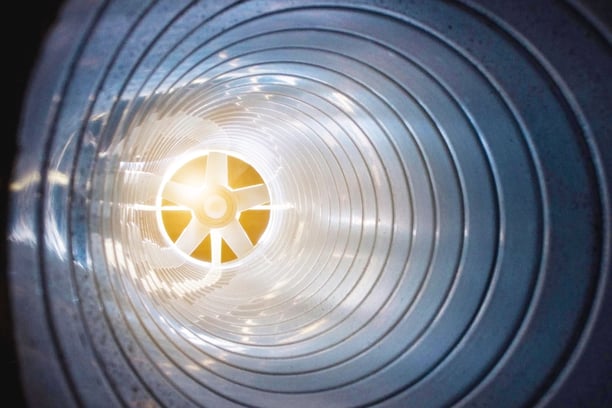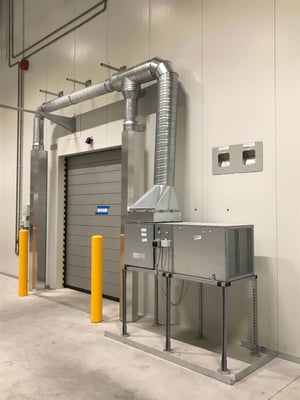
EC-fans offer more possibilities and are more efficient than AC-fans
We recommend EC fans, even if they are a little more expensive to buy than AC fans. Here we explain what they are and how fans with EC motors pay off.
EC fans
Strictly speaking, EC fans do not exist. EC is a designation for the motor and means "electronically commutated".
This technology is only required for direct current motors (DC: Direct Current) and is carried out with rectifiers or inverters.
Brushless DC motors
DC motors are among the oldest and most up-to-date electric motors for many applications.
Modern DC motors are brushless (BLDC motors: Brushless Direct Current). This allows a much simpler design, because the fixed stator is comprised by coils, while the rotor, which is equipped with a permanent magnet or intermittent permanent magnets, no longer requires a power supply.
This eliminates the need for brushes, which in conventional designs carried the current to the coils in the rotor. Mechanically, these motors are similar to AC synchronous motors.
We use so-called external rotor motors, in which the rotor (with the fan impeller) rotates around the stator.
Because the windings surround the stator and are much easier to build, multi-phase systems with many poles are possible.
Advantages of brushless DC motors
- The speed can be controlled well over a wide range.
- The torque is particularly high during start-up (the current consumption of a DC motor is highest at standstill). This means that these motors can be started and stopped more efficiently.
- The motors we use have a high efficiency and mostly meet the globally valid efficiency class IE5 "Ultra Premium" (according to the IEC TS 60034302:2016 standard).
- Less to no rare earths are required.
- Other advantages are reported by the competition, such as significantly higher efficiency and lower noise. Our research has not yet confirmed this.
As the name suggests, these motors require direct current. In most cases, our customers have alternating current beforehand, which has to be rectified:
Rectifier, Inverter
The rectification of the current is often carried out in the same breath as the so-called commutation, the reversal of polarity. The devices required for this are often called inverters.
Reversal of polarity is no longer automatic, as with the AC motor, but the current voltage and strength must be regulated for each winding. The voltage is proportional to the motor speed of a DC motor, the current strength corresponds to the torque.
When this commutation is done electronically, it is called EC: "electronically commutated". This leads many fan manufacturers to say that they offer EC fans. It is not the fan that is EC, but the motor.
We usually use motors with sinus U commutation, which results in higher torque with increased current. Alternatively, the polarity can be reversed block by block.
This control can be stepwise (if necessary with the use of Hall sensors), in which case we can speak of a stepper motor.
AC motors and frequency converters
With a classic AC electric motor (AC: Accelerating Current), the speed depends on the frequency of the supplied current (synchronous). A frequency converter (FC) enables the speed of such motors to be controlled by changing the frequency (asynchronous).
Many of our systems have such frequency converters in use. These frequency converters can often also be used to control DC motors. However, they are no longer necessary.
Advantages of AC motors
Unlike DC motors, most AC motors are brushless. They can also be operated more easily without microprocessors. This reduces the probability of failure.
In addition, they are mostly cheaper to purchase than EC motors.
In our opinion, this is outweighed by the advantages of the DC motor. For example, the efficiency is poorer, which leads to higher operating costs.
Fans
Centrifugal fans
LWT uses centrifugal fans in most cases, because only these provide high pressure. Higher pressure allows us to significantly reduce the volume flow compared to air curtains and, if required, to achieve much higher exit velocities of the air flow from the nozzle!
The fans used have a system efficiency of around 70 % thanks to efficient motor technology, fluidic optimisations, innovative materials and well thought-out design details.
Unlike other fans, these centrifugal fans blow to the side. This distinction is currently becoming somewhat blurred because centrifugal fans are constantly being further developed.
Other fans
There are many types of fans and many of them can be operated with DC motors. LWT works with high pressures. Some axial fans are now capable of high pressure. We test these.
Frequently Asked Questions
The fans can be the same. An AC fan is driven by an AC (Accelerating Current) motor, while EC motors are DC (Direct Current) motors.
Not necessarily. Many types of fans can be driven by electronically commutated (EC) DC motors.
EC fans are DC motors. The direct current is "commutated" so that the coils of the DC motor can be controlled with different current phases. This commutation is often sinusoidal, but on/off states are also used. If the commutation is done electronically, it is called EC: Electronically Commutated.
There are a few reasons. EC motors have an extended speed range and allow you to choose a suitable, performance-optimised speed. The rotating parts of some EC motors are lighter than equivalent AC motors. And, commutators can be more energy efficient than frequency converters.
EC motors are Electronically Commutated DC motors.
AC and DC motors can be brushless, namely when the non-rotating stator is controlled with current. This is usually the case with us, because we use external rotor motors. Brushless DC motors (BLDC) or AC motors are used there.





